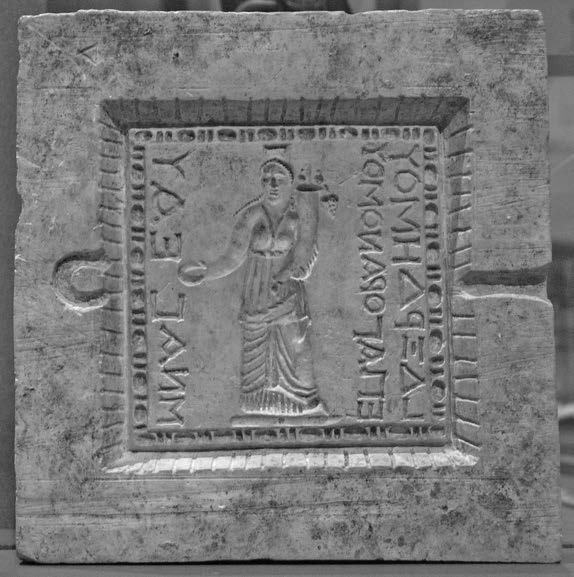
-
Copyright credit: Gatier 2016

ARCHAEOLOGICAL DESCRIPTION OF THE WEIGHT
Authority
Mnaséas, agoranomos (Sidon)
Mint
Sidon
Denomination
Material
Limestone
Manufacture
Carved
Shape
Square
Length
14.00 cm
Width
14.50 cm
Height
3.00 cm
Metrology
| Mass (g) | Mass (grain) | Date of measurement | Reference | fragmented | cleaned | reference weight |
|---|---|---|---|---|---|---|
| - | ||||||
Iconography
| Symbol | Technique | Direction | Position | Number | Synecdoche |
|---|---|---|---|---|---|
| Tyche | Incised | ||||
| Cornucopia | Incised | ||||
| Polos crown | Incised |
Wear
Corrosion
Handle
Yes
Suspension hole
Yes
Recarved mould
No
Recarved weight
No
Intentionally destroyed
No
Archaeological description
Gatier 2016: Matrice de poids (moule en calcaire crayeux). Au centre du champ, Tyché debout sur un piédestal, coiffée d’un polos et vêtue du péplos et du chiton. Elle tient à droite une corne d’abondance dans laquelle apparaissent deux grenades et une grappe de raisins qui en déborde. L’inscription est à lire en miroir, puisqu’il s’agit d’un moule matrice. Dim. : 14,5 × 14 × 3. H. l. : 0,4-0,7.
Autopsy
No
INSCRIPTION
| Language | Technique | Legend type |
|---|---|---|
| Greek | Incised | Authority, Date, Other |
Fac simile
On the mould (upper-left corner): Δ
← LΔΞΡΔΗΜΟΥ
← ΕΠΑΓΟΡΑΝΟΜΟΥ
← ΜΝΑ ΕΑΥ
Edition
On the mould (upper-left corner): Δ
(Ἔτους) δξρ´ | ἐπ’ ἀγορανόμου | Μνασέο̣υ.
Gatier 2016: Dans le coin supérieur gauche, une lettre grecque: Δ. L. 1. L pour ἔτους. L. 3. L’omicron semble être une correction d’un alpha primitivement gravé.
(Ἔτους) δξρ´ | ἐπ’ ἀγορανόμου | Μνασέο̣υ.
Gatier 2016: Dans le coin supérieur gauche, une lettre grecque: Δ. L. 1. L pour ἔτους. L. 3. L’omicron semble être une correction d’un alpha primitivement gravé.
Monogram
ARCHAEOLOGICAL CONTEXT
Findspot (region)
Lebanon: Liban-Sud (Al Janūb)
Findspot (site)
Saida [Sidon / Col. Aurelia Pia]
context
Gatier 2016: Sidon, grotte sépulcrale dans un jardin proche du sérail Fakhr al-Din. Découverte fortuite, remise à la DGA.
CIRCUMSTANCES OF ACQUISITION
Region
City
Date of first acquisition
circumstances
DATING OF THE WEIGHT
Curatorial Section
GREEK
Time frame
FROM
53
TO
54
Comments on Chronology
Civic Era 164 = 54 CE. Gatier 2016: L’ère civique (δήμου) en question est sans aucun doute celle de Sidon, ce qui correspond à 54 apr. J.‑C.
COLLECTION HISTORY
Collection
| Name | Date of acquisition | Inventory number |
|---|---|---|
| National Museum of Beirut | None | 25495 |
Bibliography
| Reference | Page/Column | Reference (number) | Plate / Figure | Comment |
|---|---|---|---|---|
| Alpi 1997 | 258–261 | None | None | (non vidi) |
| Finkielsztejn 2012 | 140–141 | 28 | None | None |
| Finkielsztejn 2015 | 83–84 | 125 | None | None |
| Gatier 2016 | 250 | 538 | fig. 538 | None |
VARIA
Additional comment
Gatier 2016: L’onomastique ne contredit pas la provenance: Mnaséas est un nom grec assez répandu en Phénicie, y compris à Sidon. Il s’agit d’un moule pour un poids de 8,7 cm de côté à l’avers, avec une tranche biseautée, pesant probablement une mine d’après ses dimensions. Comme l’écrit l’éditeur, le delta (qui ne pouvait être reproduit sur l’objet fabriqué) est une marque d’artisan plutôt qu’une abréviation pour τέταρτον («un quart»).
Finkielsztejn 2015: Lead was cast in modern times in this very well-preserved mold; its mass was 650 g, most likely the standard of 652.5 g of the very end of the second century BCE in Athens and Syria.
Finkielsztejn 2015: Lead was cast in modern times in this very well-preserved mold; its mass was 650 g, most likely the standard of 652.5 g of the very end of the second century BCE in Athens and Syria.
Permalink
External link